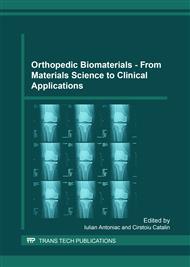[1]
H. Li, K.A. Khor, Characteristics of the nanostructures in thermal sprayed hydroxyapatite coatings and their influence on coating properties, Surface and Coatings Technology, 201 (2006) 2147-2154.
DOI: 10.1016/j.surfcoat.2006.03.024
Google Scholar
[2]
M.F. Morks, A. Kobayashi, Influence of spray parameters on the microstructure and mechanical properties of gas-tunnel plasma sprayed hydroxyapatite coatings, Materials Science and Engineering B, 139 (2007) 209-215.
DOI: 10.1016/j.mseb.2007.02.008
Google Scholar
[3]
M. Inagaki, T. Kameyama, Phase transformation of plasma-sprayed hydroxyapatite coating with preferred crystalline orientation, Biomaterials, 28 (2007) 2923-2931.
DOI: 10.1016/j.biomaterials.2007.03.008
Google Scholar
[4]
Y. Yang, J. Kyo-Han Kim, L. Ong, A review on calcium phosphate coatings produced using a sputtering process - An alternative to plasma spraying, Biomaterials, 26 (2005) 327-337.
DOI: 10.1016/j.biomaterials.2004.02.029
Google Scholar
[5]
H. Li, K.A. Khor, P. Cheang, Adhesive and bending failure of thermal sprayed hydroxyapatite coatings: Effect of nanostructures at interface and crack propagation phenomenon during bending, Engineering Fracture Mechanics, 74 (2007) 1894-(1903).
DOI: 10.1016/j.engfracmech.2006.06.001
Google Scholar
[6]
P.L. Silva, J.D. Santos, F.J. Monterio, J.C. Knowles, Adhesion and microstructural characterization of plasma-sprayed hydroxyapatite/glass ceramic coatings onto Ti-6A1-4V substrates, Surface and Coatings Technology, 102 (1998) 191-196.
DOI: 10.1016/s0257-8972(97)00576-8
Google Scholar
[7]
M. Gaona, R.S. Lima, B.R. Marple, Nanostructured titania/hydroxyapatite composite coatings deposited by high velocity oxy-fuel (HVOF) spraying, Materials Science and Engineering: A, 458 (2007) 141-146.
DOI: 10.1016/j.msea.2006.12.090
Google Scholar
[8]
A. Balamurugan, G. Balossier, S. Kannan, J. Michael, J. Faure, S. Rajeswari, Electrochemical and structural characterisation of zirconia reinforced hydroxyapatite bioceramic sol–gel coatingson surgical grade 316L SS for biomedical applications, Ceramic International, 33 (2007).
DOI: 10.1016/j.ceramint.2005.11.011
Google Scholar
[9]
M. Long, H.T. Rack, Titanium alloys in total joint replacement - a materials science perspective, Biomaterials, 19 (1998) 1621-1639.
DOI: 10.1016/s0142-9612(97)00146-4
Google Scholar
[10]
R.P. Lanza, R. Langer, J. Vacanti, Principles of Tissue Engineering, (2000) Academic Press, New York.
Google Scholar
[11]
V. Karageorgiou, D. Kaplan, Porosity of 3D biomaterial scaffolds and osteogenesis, Biomaterials, 26 (2005) 5474-5471.
DOI: 10.1016/j.biomaterials.2005.02.002
Google Scholar
[12]
K. Rezwan, Q.Z. Chen, J.J. Blaker, A.R. Boccaccini, Biodegradable and bioactive porous polymer/inorganic composite scaffolds for bone tissue engineering, Biomaterials, 27 (2006) 3413-3431.
DOI: 10.1016/j.biomaterials.2006.01.039
Google Scholar
[13]
V. Guarino, F. Causa, L. Ambrosio, Bioactive scaffolds for bone and ligament tissue, Expert Review of Medical Devices, 4 (2007) 405-418.
DOI: 10.1586/17434440.4.3.405
Google Scholar
[14]
K. Zhang, Y. Wang, M.A. Hillmayer, L. F Francis, Processing and properties of porous poly(L-lactide)/bioactive glass composites, Biomaterials, 25 (2004) 2489-2500.
DOI: 10.1016/j.biomaterials.2003.09.033
Google Scholar
[15]
C. Renchini, E. Girardin, A.S. Fomin, A. Manescu, A. Sabbioni, S.M. Barinov, V.S. Komlev, G. Albertini, F. Fiori, Plasma sprayed hydroxyapatite coatings from nanostructured granules, Materials Science and Engineering: B, 152 (2008) 86-90.
DOI: 10.1016/j.mseb.2008.06.016
Google Scholar
[16]
C. Renghini, V. Komlev, F. Fiori, E. Vernè, F. Baino, C. Vitale-Brovarone, Micro-CT studies on 3-D bioactive glass-ceramic scaffolds for bone regeneration, Acta Biomaterialia, 5 (2009) 1328-1337.
DOI: 10.1016/j.actbio.2008.10.017
Google Scholar
[17]
O. Bretcanu, S. Misra, I. Roy, C. Renghini, F. Fiori, A.R. Boccaccini, V. Salih, In vitro biocompatibility of 45S5 Bioglass®‐derived glass–ceramic scaffolds coated with poly (3‐hydroxybutyrate), Journal of Tissue Engineering and Regenerative Medicine, 3 (2009).
DOI: 10.1002/term.150
Google Scholar
[18]
V. Komlev, M. Mastrogiacomo, F. Peyrin, R. Cancedda, F. Rustichelli, X Ray Synchrotron Radiation Pseudo-Holotomography as a New Imaging Technique to Investigate Angio- and Microvasculogenesis with No Usage of Contrast Agents, Tissue Engineering Part C, 15 (2009).
DOI: 10.1089/ten.tec.2008.0428
Google Scholar
[19]
V.S. Komlev, S.M. Barinov, E.V. Koplik, A method to fabricate porous spherical hydroxyapatite granules intended for time-controlled drug release, Biomaterials, 23 (2002) 3449-3454.
DOI: 10.1016/s0142-9612(02)00049-2
Google Scholar
[20]
V. Hauk, Structural and Residual Stress Analysis by Nondestructive Methods, (1997) Elsevier, Amsterdam.
Google Scholar
[21]
S. Nuzzo, F. Peyrin, P. Cloetens, J. Baruchel, G. Boivin, Quantification of the degree of mineralization of bone in three dimensions using synchrotron radiation microtomography, Medical Physics, 19 (2002) 2672–268.
DOI: 10.1118/1.1513161
Google Scholar
[22]
M. Salomé, F. Peyrin, P. Cloetens, C. Odet, A.M. Laval-Jeantet, J. Baruchel, P. Spanne, A synchrotron radiation microtomography system for the analysis of trabecular bone samples, Medical Physics, 26 (1999) 2194-2204.
DOI: 10.1118/1.598736
Google Scholar


